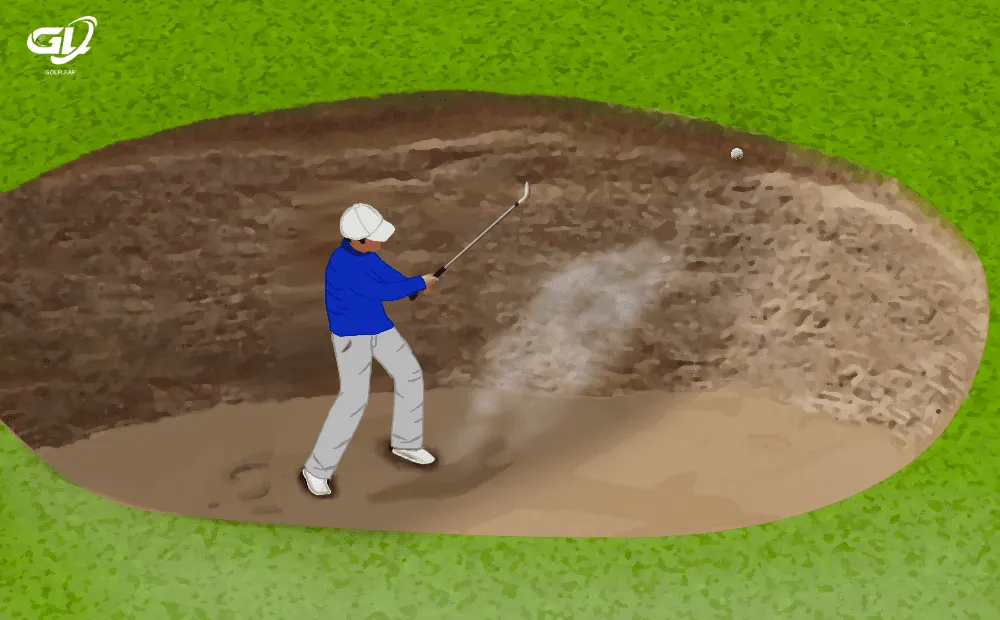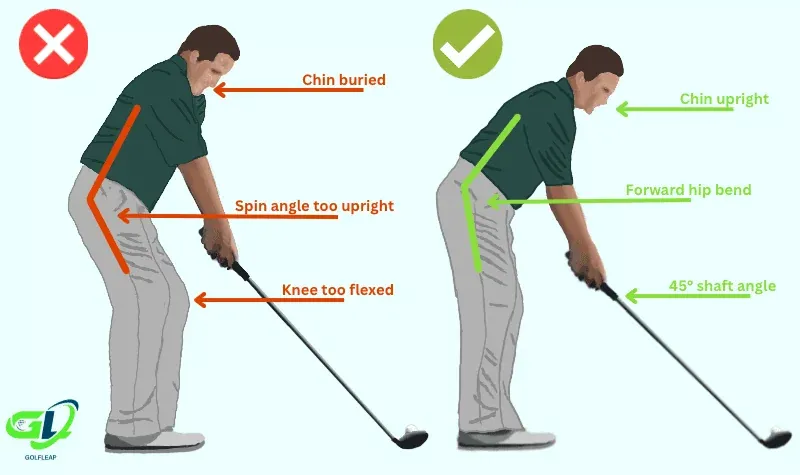
Ever wondered how to hit out of fairway bunkers? My advice, don’t just ‘wing it’ like most do, if you’re serious about golf, actually practice it.
Hitting great shots out of fairway bunkers begins by learning how to ask yourself the right questions to build more self-belief and take a confident swing. A high number of golfers have no clue where to start their decision-making from fairway bunkers, but thankfully for you, we’ve narrowed it down to a simple step-by-step process.
Most recreational golfers get in their own way when they find their ball in a fairway bunker, getting nervous and making anxious or unfocused swings. After you see how we and other great golfers tackle these types of shots, you’re going to wonder why you spent so much time worrying about them!
We’re going to serve as the knowledgeable golf friend or coach you’ve always wanted to teach you the tips and tricks to hitting fairway bunker shots with ease.
Let’s begin!
P.S. Be sure to learn how to play the greenside bunker shot and not just fairway bunkers as you’re likely going to be in those more!
Table of Contents
Pre-Shot: Assessing Your Fairway Bunker Shot
The majority of the work required to hit a great fairway bunker shot is actually accomplished before you ever take your swing.
Let us explain what we mean by that:
Step 1: Assess the Lie
Bunkers are considered a “hazard” on the golf course, meaning they were put in specific places to punish our bad shots.
This means you run the risk of having a perfect lie, a “plugged” lie, or a “fried egg” lie when you hit the ball there (we’ll discuss those in more detail later).
If you find yourself with a great lie in the bunker (fingers-crossed), you can move on to the next step, which is asking yourself the following questions:
- Does my fairway bunker have a lip to clear with my shot?
- What is the distance to my target? (Be precise with an Affordable Rangefinder)
- If I were in the middle of the fairway, what club would I use to reach the target?
- Does my club choice get high enough to clear my bunker’s lip easily?
Step 2: Assessing the Bunker Lip To Use the Right Club
If the lip of your fairway bunker is chest high or higher (like the first image you see above), and you’re outside the comfortable range of your highest lofted clubs (like the pitching wedge or 9-8 Iron), you should really be thinking about damage avoidance rather than sticking it close if you consider yourself a mid to higher handicap golfer.
As another example, say you’re 160 yards out and don’t feel like your 7 iron would launch high enough to get over the lip 100% of the time. Your only smart options are to move down to an 8 or 9 iron to ensure you make it out of the bunker by launching the ball higher, or pitching out sideways to give yourself a better upcoming shot.
If you have little to no bunker lip and are close enough to your target that you feel like you could reach it easily, you can move onto the next step with confidence.
Step 3: Assessing Distance and Club Selection with Fairway Bunker Shots

When I walk up to my fairway bunker shot, before I ever step anywhere near the sand, I take out my rangefinder and shoot my target. This gives me a good idea of my potential club choice and saves me from having to spend more time raking the bunker after my shot.
This could be laziness on my part, but it keeps everyone’s pace-of-play faster and saves energy.
When choosing your club, imagine adding between 5 and 8 more yards to your yardage estimation. We add a half-club of distance to our shot because it’s so difficult to make absolutely clean contact from the sand and another reason that we’ll discuss in our next step.
If you’re a higher handicap golfer that isn’t completely confident in your ball-striking ability, we wouldn’t recommend choosing a lower lofted club than your 8 iron. If you consider yourself a “more experienced golfer,” you have much more freedom in your club selection.
Step 4: Grip Down and Club Up
A crucial element to hitting great fairway bunker shots is gripping down on the shaft between a half-inch to an inch and a half.
Great golfers do this to lower their likelihood of hitting the ball fat and leaving themselves inside the bunker for their upcoming shot. Choking up on the shaft raises the low point of our swing (where the club makes contact with the turf), and helps us create cleaner, crisp contact.
Additionally, we aren’t going to swing full out at a fairway bunker shot (the primary reason to club up). Swinging with 100% force increases our chances of having a foot slip (losing balance), or having our feet sink into the sand, which lowers the low point of our swing and increases our chances of chunking.
Never swing harder than 75-80% on fairway bunker shots. This keeps your lower body more stable and increases your chances of making solid contact with high launch.
Step 5: Body Positioning/Stance and Ball Positioning
We only have two real pieces of advice for body positioning in the bunker: 1. Don’t dig your feet deeply into the sand like a greenside bunker shot. 2. Feel “Flat Footed” rather than feeling your weight shift significantly to your rear side during the backswing like other golf shots.
- Digging your feet into the sand makes it easier to chunk the shot by lowering the low point of your swing.
- Shifting your weight during a fairway bunker swing can cause our feet to slip or shift deeper into the sand causing more problems.
Regardless of what club you’ve selected, we strongly suggest you keep your ball position the same as if you were hitting it from the fairway. Moving the ball too far forward makes you more likely to hit a shot thin and hitting the lip of your bunker. Moving the ball further back in your stance makes it easier to top the ball and hit it nowhere.
Step 5: Posture
On top of feeling “Flat Footed” with a minimal weight shift during fairway bunker shots, a key thought to have is feeling your chin slightly raised-up for a more upright posture.
Feeling your chin lifted up slightly from its normal position can help you maintain your weight on your leading side better and helps avoid hitting too far behind the golf ball!
*Tip* If you feel like you’re struggling to stop shifting your weight back during these types of shots, imagine feeling your arms doing the majority of the work during your swing, rather than your body and rotational forces like a normal swing.
Step 6: Swing with Full Commitment
The final step to hitting consistently great fairway bunker shots is fully committing to your swing. The majority of recreational golfers are anxious and unconfident with their fairway bunker swing because they didn’t know the necessary steps we’ve laid out to feel committed to great results!
Now that you know the step-by-step process great golfers use to evaluate their fairway bunker shots and eliminate anxiety before they ever take their swing, you’re well on your way to hitting great shots from these positions.
Bonus: What To Do With Bad Lies
Since bunkers were designed to be difficult, this means your ball will sometimes find a perfect lie in the sand (similar to sitting in the middle of the fairway), or other times it can be “Plugged,” or in a “Fried Egg.”

Plugged bunker lies (where the ball is buried in the sand with little left exposed) usually results from your golf ball hitting the lip (where more moisture can be held in the sand) or landing directly into a bunker with extra wet sand.
Fried Egg bunker lies (where the ball sits halfway in the sand) result from the ball splashing into an area of the bunker with softer, drier sand.
Both the “Plugged” and “Fried Egg” bunker lies leave you with only one option:
“Take your medicine” by grabbing a wedge and put yourself back in the fairway for your next shot.
Bonus: What To Do With Up-Hill or Down-Hill Fairway Bunker Shots

Most golfers don’t realize hitting off an upslope changes the loft of their club automatically. From an upslope, the golf ball travels much higher with more spin and doesn’t go as far in overall length.
When we’re faced with a fairway bunker shot from an up-hill lie, our first goal is clubbing up (since we know the ball isn’t going to go as far as it normally would from a flat lie), and our second goal is making our shoulder angle match the angle of our upslope.
By creating the same angle with our shoulders as the slope we’re standing on, we put our body in a position to make clean contact instead of hitting too sharply down on the ball and hitting it fat and short of our target.
From a down-hill lie, things get slightly more complicated. Down-hill shots do the opposite of up-hill lies and lower the loft of your club, making the ball launch much lower with less spin and height. This makes evaluating your club selection much more challenging since you need a high lofted club to launch high enough to clear the lip of your bunker.
Our best suggestion with down-hill fairway bunker shots is to take the lowest lofted club you know will get over your bunker lip (also matching your shoulder angle to the angle of the slope), or pitch out sideways to put yourself in a good position for your next shot.
Final Thoughts on How to Hit Out of Fairway Bunkers
We truly believe if you follow our simple steps we’ve listed above, you’re going to hit great fairway bunker shots.
The most critical things to remember are assessing your lie and distance (plus a half-club more) before ever taking your stance behind the ball. If you take some of the “guess-work” out of your shot before you set up by following our steps, you’ll automatically feel more confident by making an educated “process-based” decision.
While there are some situations where it’s crucial to take your medicine and punch out sideways, there are plenty of fairway bunker situations that can be turned into great results by knowing the proper steps to follow once you get there.
Like what you read or learned here? If so, check out these other helpful posts:

